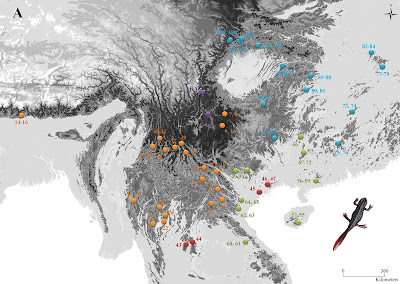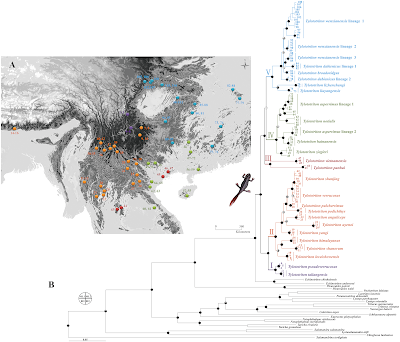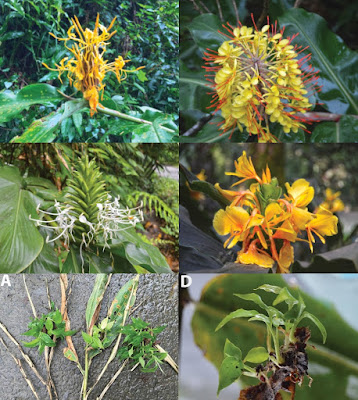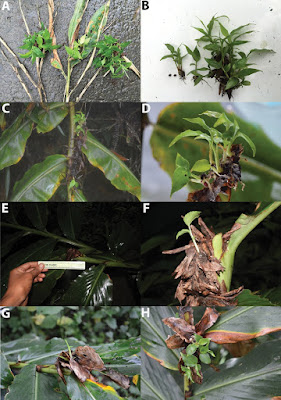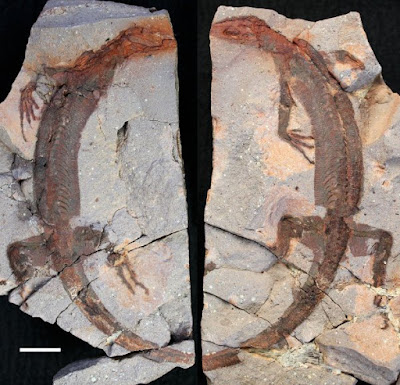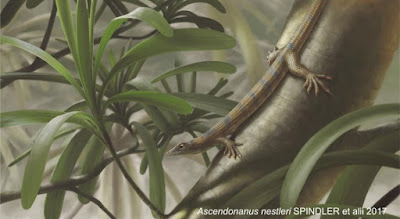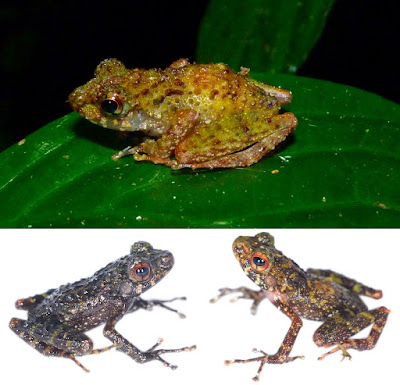[Most Recent Entries] [Calendar View]
Friday, March 16th, 2018
| Time | Event | ||||
| 1:55a | [Herpetology • 2018] Phylogenetic Surveys on the Newt Genus Tylototriton sensu lato (Salamandridae, Caudata) reveal Cryptic Diversity and Novel Diversification Promoted by Historical Climatic Shifts
Abstract Global climatic transitions and Tibetan Plateau uplifts are hypothesized to have profoundly impacted biodiversity in southeastern Asia. To further test the hypotheses related to the impacts of these incidents, we investigated the diversification patterns of the newt genus Tylototriton sensu lato, distributed across the mountain ranges of southeastern Asia. Gene-tree and species-tree analyses of two mitochondrial genes and two nuclear genes revealed five major clades in the genus, and suggested several cryptic species. Dating estimates suggested that the genus originated in the early-to-middle Miocene. Under different species delimitating scenarios, diversification analyses with birth-death likelihood tests indicated that the genus held a higher diversification rate in the late Miocene-to-Pliocene era than that in the Pleistocene. Ancestral area reconstructions indicated that the genus originated from the northern Indochina Peninsula. Accordingly, we hypothesized that the Miocene Climatic Transition triggered the diversification of the genus, and the reinforcement of East Asian monsoons associated with the stepwise uplifts of the Tibetan Plateau promoted the radiation of the genus in southeastern Asia during the Miocene-to-Pliocene period. Quaternary glacial cycles likely had limited effects on speciation events in the genus, but mainly had contributions on their intraspecific differentiations.
Conclusions: Our findings provided evidence for the profound influences of historical climate shifts especially associated with the uplift of the Tibetan Plateau on the diversification of animals occurring in the southeastern Asia. The results basically confirmed the reports on plant lineages, such as Rheum (Sun et al., 2012), Lepisorus (Wang et al., 2012a; Wang et al., 2012b), Juniperus (Mao et al., 2010) and Isodon (Yu et al., 2014), and on animal groups, such as Chiastocheta Pokorny, 1889 (Anthomyiidae, Diptera, Insecta; Espíndola, Buerki & Alvarez, 2012) and spiny frogs (Dicroglossidae, Anura, Amphibia; Che et al., 2010). Yet the present study further supplied some other indications. Primarily, although diversification of the newt group was promoted by the climatic shifts, several factors, for example, niche limits and their intrinsic low dispersal capacity, might have contributed to their Pleistocene rate-slowdown diversification. In addition, this study provided a putative “complete” species tree for Tylototriton s.l. to date. The inclusion of many putative cryptic species in the diversification analyses seems to be effective in finding diversification models of the group. But at present, wild populations of Tylototriton s.l. show a significant decline due to many reasons, such as climate changes, human capture and habitat deterioration. Further deep investigations of undetected cryptic lineages might supply the basic requirement for disclosing “true” diversification history of the taxa. Bin Wang, Kanto Nishikawa, Masafumi Matsui, Truong Quang Nguyen, Feng Xie, Cheng Li, Janak Raj Khatiwada, Baowei Zhang, Dajie Gong, Yunming Mo, Gang Wei, Xiaohong Chen, Youhui Shen, Daode Yang, Rongchuan Xiong and Jianping Jiang. 2018. Phylogenetic Surveys on the Newt Genus Tylototriton sensu lato (Salamandridae, Caudata) reveal Cryptic Diversity and Novel Diversification Promoted by Historical Climatic Shifts. PeerJ. 6:e4384. DOI: 10.7717/peerj.4384 | ||||
| 2:05a | [Herpetology • 2018] Pristimantis antisuyu & P. erythroinguinis • Two New Species of Terrestrial-breeding Frogs (Anura, Strabomantidae) from the eastern Slopes of the Andes in Manu National Park, Peru
Abstract We describe two new species of Pristimantis from the Kosñipata valley in the eastern slopes of the Andes near Manu National Park, Peru. The two new species are closely related but do not overlap elevationally: Pristimantis antisuyu sp. n. occurs from 1485–1823 m a.s.l., whereas Pristimantis erythroinguinis sp. n. occurs from 930–1255 m a.s.l. Both species are readily distinguished from all other species of Pristimantis but P. cruciocularis and P. flavobracatus by possessing an iris with a cruciform pattern, no tympanum, and red bright or yellow coloration on groin. We used a Maximum Likelihood approach to infer a molecular phylogeny on a dataset composed of 27 terminals and 903 bp of the concatenated 16S rRNA and COI mitochondrial fragments. Our phylogenetic analyses indicate that, despite differing in groin coloration from red to yellow, individuals of P. cruciocularis and P. flavobracatus form a single clade, and some specimens have identical 16S sequences. Therefore, we synonymize P. flavobracatus with P. cruciocularis. The two unnamed species are closely related to P. cruciocularis. Pristimantis antisuyu sp. n. differs from P. cruciocularis and P. erythroinguinis sp. n. by having smaller yellow spots, instead of extensive red coloration, on groin and hind limbs, by being larger with proportionally longer tibias, and by having an inner metatarsal tubercle three times the size of outer metatarsal tubercle (twice as long in the other two species). Pristimantis erythroinguinis sp. n., despite having coloration very similar to P. cruciocularis, is the sister taxon to both P. antisuyu sp. n. and P. cruciocularis, and can be distinguished from the latter by having much darker ventral coloration, and no cream or yellow spots on flanks and surrounding the red inguinal marks. Keywords: Amphibia, Amazon Basin, Brachycephaloidea, frog, cloud forest, Paucartambo, phylogenetics, synonymy, taxonomy, Terrarana Alessandro Catenazzi and Edgar Lehr. 2018. Pristimantis antisuyu sp. n. and Pristimantis erythroinguinis sp. n., Two New Species of Terrestrial-breeding Frogs (Anura, Strabomantidae) from the eastern Slopes of the Andes in Manu National Park, Peru. 4394(2); 185–206. DOI: 10.11646/zootaxa.4394.2.2 Two new frog species for Manu National Park - Catenazzi Lab CatenazziLab.org/1/post/2018/03/two-new-frog-species-f | ||||
| 3:32a | [Botany • 2018] Describing Terminologies and Discussing Records: More Discoveries of Facultative Vivipary in the Genus Hedychium J.Koenig (Zingiberaceae) from Northeast India
Abstract The authors introduce the term facultative vivipary for the first time in gingers and elaborate on this reproductive strategy. Four new observations of facultative vivipary are reported in the genus Hedychium which were discovered during botanical explorations by the authors in Northeast India (NE India) over the past three years. The viviparous taxa are H. marginatum C.B.Clarke, H. speciosum var. gardnerianum (Ker Gawl.) Sanoj & M.Sabu (previously, H. gardnerianum Sheppard ex Ker Gawl.), H. thyrsiforme Buch.-Ham. ex Sm. and H. urophyllum G.Lodd. The authors also attempt to summarise the occurrence of vivipary in the family Zingiberaceae from published reports and to clarify a taxonomic misidentification in a previously known report of vivipary in Hedychium elatum. Keywords: Facultative vivipary, gingers, Meghalaya, Nagaland, phenology, pseudovivipary, recalcitrant seeds
Ajith Ashokan and Vinita Gowda. 2018. Describing Terminologies and Discussing Records: More Discoveries of Facultative Vivipary in the Genus Hedychium J.Koenig (Zingiberaceae) from Northeast India. PhytoKeys 96: 21-34. DOI: 10.3897/phytokeys.96.23461 | ||||
| 10:51a | [Paleontology • 2018] Ascendonanus nestleri • First Arboreal 'Pelycosaurs' (Synapsida: Varanopidae) from the early Permian Chemnitz Fossil Lagerstätte, SE Germany, with A Review of Varanopid Phylogeny
Abstract A new fossil amniote from the Fossil Forest of Chemnitz (Sakmarian-Artinskian transition, Germany) is described as Ascendonanus nestleri gen. et sp. nov., based on five articulated skeletons with integumentary preservation. The slender animals exhibit a generalistic, lizard-like morphology. However, their synapsid temporal fenestration, ventrally ridged centra and enlarged iliac blades indicate a pelycosaur-grade affiliation. Using a renewed data set for certain early amniotes with a similar typology found Ascendonanus to be a basal varanopid synapsid. This is the first evidence of a varanopid from Saxony and the third from Central Europe, as well as the smallest varanopid at all. Its greatly elongated trunk, enlarged autopodia and strongly curved unguals, along with taphonomical observations, imply an arboreal lifestyle in a dense forest habitat until the whole ecosystem was buried under volcanic deposits. Ascendonanus greatly increases the knowledge on rare basal varanopids; it also reveals a so far unexpected ecotype of early synapsids. Its integumentary structures present the first detailed and soft tissue skin preservation of any Paleozoic synapsid. Further systematic results suggest a varanodontine position for Mycterosaurus, the monophyly of South African varanopids including Anningia and the distinction of a skeletal aggregation previously assigned to Heleosaurus, now renamed as Microvaranops parentis gen. et sp. nov. Keywords: Arboreality, Synapsid phylogeny, Adaptation, Cisuralian, Soft tissue preservation, Volcanic taphonomy Frederik Spindler, Ralf Werneburg, Joerg W. Schneider, Ludwig Luthardt, Volker Annacker and Ronny Rößler. 2018. First Arboreal 'Pelycosaurs' (Synapsida: Varanopidae) from the early Permian Chemnitz Fossil Lagerstätte, SE Germany, with A Review of Varanopid Phylogeny. PalZ. DOI: 10.1007/s12542-018-0405-9 Vortrag: Saurier unter Chemnitz – neue Erkenntnisse aus dem Versteinerten Wald Abstract: The palaeontological collection of Chemnitz has been a constantly growing, developing and limitless source of knowledge on the relation of earth’s history and the development of life on earth, for over three centuries. Initially founded by science interested citizens on a voluntary basis, only with the premise to enable public access to collections and scientific information, it has developed and has been structuralized based on professional geoscientific considerations. Today, the collection is preserved, added to through selected purchases, diversely used and it serves as a foundation for globally linked up scientific research, as well as for interdisciplinary exhibitions and diverse educational programs and activities. The essence of the collection documents the evolution and preservation of terrestrial ecosystems with a special emphasis on volcanic environments and petrified wood. Ronny Rößler and Thorid Zierold. 2017. Die paläontologische Sammlung des Museums für Naturkunde Chemnitz – eine Zeitreise zu den Wurzeln der Paläobotanik. Veröff. Museum für Naturkunde Chemnitz. 40; 5-30. | ||||
| 11:20a | [Herpetology • 2018] Gephyromantis lomorina • A Distinctive New Frog Species (Anura, Mantellidae) supports the Biogeographic Linkage of Two Montane Rainforest Massifs in northern Madagascar
Abstract We describe a new species of the genus Gephyromantis, subgenus Gephyromantis Vatomantis (Mantellidae, Mantellinae), from moderately high elevation (1164–1394 m a.s.l.) on the Marojejy, Sorata, and Andravory Massifs in northern Madagascar. The new species, Gephyromantis (Vatomantis) lomorina sp. n. is highly distinct from all other species, and was immediately recognisable as an undescribed taxon upon its discovery. It is characterised by a granular, mottled black and green skin, reddish eyes, paired subgular vocal sacs of partly white colour, bulbous femoral glands present only in males and consisting of three large granules, white ventral spotting, and a unique, amplitude-modulated advertisement call consisting of a series of 24–29 rapid, quiet notes at a dominant frequency of 5124–5512 Hz. Genetically the species is also strongly distinct from its congeners, with uncorrected pairwise distances ≥10 % in a fragment of the mitochondrial 16S rRNA gene to all other nominal Gephyromantis species. A molecular phylogeny based on 16S sequences places it in a clade with species of the subgenera Laurentomantis and Vatomantis, and we assign it to the latter subgenus based on its morphological resemblance to members of Vatomantis. We discuss the biogeography of reptiles and amphibians across the massifs of northern Madagascar, the evidence for a strong link between Marojejy and Sorata, and the role of elevation in determining community sharing across this landscape. Key Words: Bioacoustics, Biogeography, Marojejy, Montane Endemism, Sorata, Taxonomy
Gephyromantis (Vatomantis) lomorina sp. n. Diagnosis: A species assigned to the genus Gephyromantis on the basis of its granular skin, moderately enlarged finger tips, small femoral glands consisting of a small number of large granules and present in males only (thus of type 2 as defined by Glaw et al. 2000), and bifid tongue. Within the genus Gephyromantis, assigned to the subgenus Vatomantis on the basis of its small size, connected lateral metatarsalia, absence of an outer metatarsal tubercle, paired subgular vocal sacs of partly whitish colour, greenish skin colouration, and riparian ecology. Gephyromantis lomorina sp. n. is characterized by the possession of the following suite of morphological characters: (1) granular skin, (2) reddish eyes, (3) mottled green and black skin, (4) males with paired subgular vocal sacs of partly white colour, (5) males with bulbous type 2 femoral glands consisting of a small number (2–3) of large granules, (6) white spots on the venter, (7) SVL 20.2–25.5 mm, and (8) fourth finger much longer than second. Furthermore, the species is characterised by distinctive, 1681–1827 ms advertisement calls of relatively low intensity, consisting of 24–30 individual pulsed notes, with 2–4 pulses per note, an inter-note interval of 41–75 ms, and a dominant frequency of 5124–5555 Hz. DNA sequence data from the 16S gene fragment supports the high divergence of this taxon to all other Gephyromantis, and is in agreement with its subgeneric assignment, albeit without statistical support (Fig. 1). .... Etymology: The specific epithet is the Malagasy word lomorina, meaning ‘covered in moss’, in reference to the green, mossy appearance of the species in life. It is used as an invariable noun in apposition to the genus name. Available names: There are no other, earlier names currently available (e.g., junior synonyms) that are assignable to the subgenera Vatomantis or Laurentomantis and that could apply to the new species. Distribution: The new species is known from three localities in northeastern Madagascar: (1) Marojejy National Park (type locality), (2) Sorata massif, and (3) Andravory massif (Fig. 6). All specimens were collected between 1164 and 1394 m a.s.l. Natural history: Specimens were collected near mountain streams in pristine montane riparian rainforest (Fig. 4g). In Marojejy National Park they were encountered during and after light rain, sitting in inconspicuous locations, especially on the fronds of tree ferns, but also on other low vegetation, between a few centimetres and up to 2 m above the ground. Specimens in Sorata were found in similar positions during dry weather, in the days just before the beginning of the rainy season. Males called irregularly and softly (see the call description above). Population density in Marojejy was remarkably high, with around three or four individuals being found along a 10 m stretch of stream. The observed density in Sorata was lower, possibly due to the absence of rain during the observation period. The species occurred in close sympatry with a number of other mantellids, but only few of these (especially Mantidactylus aff. femoralis) were found in the same microhabitat. Several specimens from Marojejy had pinkish mites (probably of the genus Endotrombicula; see Wohltmann et al. 2007) embedded within translucent whitish pustules on the skin of their fingers, toes, and bodies. Nothing is known about the reproduction of this species, but the calling sites suggest an association with lotic water. Mark D. Scherz, Oliver Hawlitschek, Jary H. Razafindraibe, Steven Megson, Fanomezana Mihaja Ratsoavina, Andolalao Rakotoarison, Molly C. Bletz, Frank Glaw and Miguel Vences. 2018. A Distinctive New Frog Species (Anura, Mantellidae) supports the Biogeographic Linkage of Two Montane Rainforest Massifs in northern Madagascar. Zoosystematics and Evolution. 94(2); 247-261. DOI: 10.3897/zse.94.21037 |
| << Previous Day |
2018/03/16 [Calendar] |
Next Day >> |

